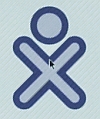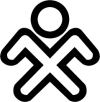
[The "XO" icon] looks very much like a symbol widely associated with mortality, toxicity and military killing - the skull and crossbones [...] The binding of the symbol to these horrific meanings is a reflection of a biological fact about the last parts of a human corpse to decay, and is not especially tied to a particular culture.Personally, I don't see that myself, but I can see his point. The "XO" icon could be seen in a non-positive way if you are more familiar with other cultures or even chemistry, than Boston-centric thinking. Docdtv does suggest one alternative:
One example is direct use of the oldest Chinese ideograph for child/baby, as shown in the graphic [here]. What appears to be something of a derivative was in fact used within the logo for the International Year of the Child in 1979.If we are to discuss changing the OLPC logo, I would like to suggest another. The logo currently used by One Laptop Per Nepali Child. This logo, a direct derivative of the OLPC XO symbol, gives "shoulders" to the child, disassociating it with the skull and crossbones motif and may give the computer a more adult-esque, teenager appealing look.Note that a large head/torso ratio not only reflects the biology of children, but also the way in which child-made art focuses on the head in early Lowenfeld developmental stages.
Either way, what OLPC XO icon look would appeal to you? Or better yet, your child, or your students? And if it is the current icon, what does it say to you?




Personally, my earliest impression of the current logo is a stick figure, but after I look at it for more than 10 seconds I can only see two sticks and a ball -- which is actually just as fitting. And I never even understood the Nepali one until you just explained it right here; it just looked like hockey sticks to me, which made no sense.
I remember thinking that Cingular could take some notes from the XO logo, which is far less irritating to look at repeatedly/ubiquitously than theirs is. And I just don't see the skull-and-bones; it's a stretch for me. You'd have to somehow assume the two sticks look like bones, and from that derive that the circle is a skull, because no one assumes that a circle represents a skull except through context.
I like original logo. I was thinking it came from tic-tac-toe game you play in school and I was thinking is nice to use this as logo for kids laptop :)
Also for me it is a child draw in the most simple way, and in the same time in very computer, even "assembler" way.
The Nepali logo to me looks to close to swastika and modern neo-nazi symbols. I know this symbols have different meaning for people from Asia, but I think in Europe the connotations are too strong.
Nepali Logo is quite meaningfull.
Beside it's one meaning about a child, It represents other strong meaning also.
Nepal is a country of Himalayas, and first half of the logo represents the himalayas with the sun. Sun is the symbole of light and light is symbole of knowledge.
It is modified XO which signifies the context of nepal.
I see the skull and crossbones in the symbol. That's how I got here, looking for the poison symbol on Google. Why would anything for kids have this imagery? Why not a child's face or many faces? Like United Colors of Benetton?
I don't see no skull and crossbones there. What I do see is a circle above a giant X. ☠